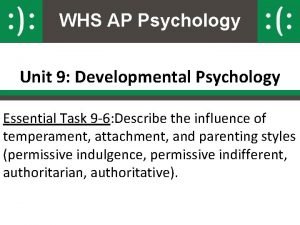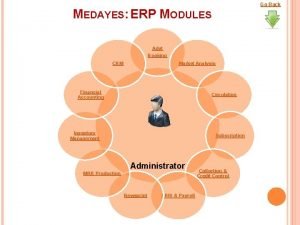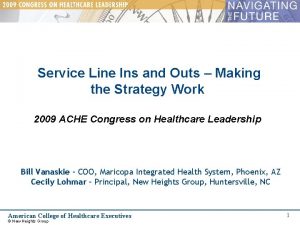HiTouch Healthcare TIME MANAGEMENT WHAT TO EXPECT IN























- Slides: 23

Hi-Touch Healthcare

TIME MANAGEMENT

WHAT TO EXPECT IN THIS PRESENTATION Overview of job burnout Activity #1: Job Stressors Quiz Activity #2: Who? Me? Stressed? Role-Play Addressing causes of burnout Activity #3: Planning Activity #4: How Many Fit? Activity #5: We Got The Power! Three powerful time management tips 1) Say no 2) Time chunking 3) Hangman’s lesson

JOB STRESSORS QUIZ ACTIVITY Answer is: 20 million • Correct response: What is the number of newly insured since 2010 due to Affordable Care Act? (U. S Department of Health and Human Services, 2016) Answer is: 29% increase • Correct response: Percentage increase of primary care workload between 2005 -2025 without the ACA impact! (Schwartz, 2012) Answer is: Most likely to suffer job burnout • Correct response: Who are healthcare workers? (Jennings, 2008; Lyndon, 2016) Answer is: Two trends adding to stress • Correct response: What are technology and interprofessional collaboration ? (Mayo Clinic, 2016; Wachter, 2013).

WHO? ME? STRESSED? ACTIVITY Complete the worksheet Form groups of 3– 4 Create your “stress-skit” Enjoy the show!

WHAT IS BURNOUT (MAYO CLINIC, 2015) Definition • “Job burnout is a special type of job stress — a state of physical, emotional, or mental exhaustion combined with doubts about your competence and the value of your work” Some Causes • Loss of control • Mismatch in values • Work-life balance • Unclear job expectations • Dysfunctional workplace dynamics

LACK OF CONTROL

PLANNING ACTIVITY: SIDE A Partner up! • Quickly review the planning descriptions on SIDE A of the handout ONLY. ―Discuss your planning style with your partner. ―Reveal effective and ineffective planning outcomes from recent history. • Large group share.

PLANNING ACTIVITY: SIDE B HOW WELL DO YOU PLAN? Please turn over the “Planning Activity” worksheet to SIDE B and complete it. • Work independently and quietly. “If you don't know where you are going, you'll end up someplace else. ” ― Yogi Berra

PLANNING SCORES & NEXT STEPS 6 -10: Terrible Planner 11 -15: Below average planner 16 -20: Average planner 21 -25: Aboveaverage planner 26 -30: Excellent planner —or— candidate for burnout? Start by taking a time management course. Evaluate and adopt planning tools and effectiveness techniques. It’s working. Focus on your priorities & daily plan. Keep up the good work. Use periodic reviews to be sure you’re planning around what matters most in your life. You have mastered planning. Make sure you’re in control of your planning rather than letting it control you. n a l p n a c “We t a h w l o r to cont we can!”

MISMATCH IN VALUES & WORK-LIFE BALANCE What is the use of running when we are on the wrong road? -Bavarian proverb

HOW MANY FIT?

MOMENT OF TRUTH “The key is not to prioritize what's on your schedule, but to schedule your priorities. ” -Stephen Covey

What are the big rocks in your life? Time with your loved ones? A musical instrument? Your favorite hobby? Your faith, your education, your finances? A cause? Remember to put these Big Rocks in first: Align your values, and practice at work-life balance.

WORKPLACE COMMUNICATION Dysfunctional workplace dynamics “Unclear job expectations

WE GOT THE POWER: RELATIONAL COMMUNICATION A one-up message: • Expresses dominance and takes the form of a command. • EX: “Enter that patient data. ” A one-down message: • Communicates submission or acceptance of the other person’s decisionmaking ability. • Statement EX: “Wherever you think we should move the gurney is fine with me. ” • Questions EX “Where would you like to have the gurney moved? ” A one-across message: • Conveys neutrality in the relationship. • Factual statements EX: “There are many brands of scrubs to choose from. ” (Floyd, 2017)

WE GOT THE POWER: COMMUNICATION ACTIVITY Partner up! Decide on a situation such as “cleaning up a code brown” or “transporting a patient” Practice via role-play the three verbal relational communication styles • 1) One-up: dominant uses command • 2) One-down: submissive uses question or statement • 3) One-across: neutral uses statements of fact

TIME MANAGEMENT TIP: EVERYONE NEEDS TO “NO. ” Learn to say “no. ” • Ask yourself these four questions: 1) Am I really and truly into this? 2) Does it align with my “big rocks? ” 3) Do I have time in my schedule or can I drop something else from my schedule? 4) Am I simply seeking approval?

BEFORE YOU SAY ANYTHING SAY “DU” DE-CATASTROPHIZE (de-cat-a-straw-fize) UN-EMOTIONALIZE (un-emo-shun-a-lize)

NO BY JOE No with empathy – “It sounds like this is an important project. I wish I could take that on, but our team’s plate is full right now with other high priority items. ” Not now but later – “We are booked solid through next week with other high priority tasks. Would the following week still meet your timeframe? ” No, unless… – “We would need to shift our current priorities and resources to take this on right now. Would you prioritize this above [Project B]? If so, are you ok if we delay [Project B] to make room for this? ” Or “do we need to increase our budget to bring in more resources to handle this? ” No, but maybe someone else? “Do you think So-and-So’s team could help with this? ” (Baker, 2013)

TIME CHUNKING

DEMOCRATIC __ __ __

THANK YOU! Questions? Comments?
 Healthcare and the healthcare team chapter 2
Healthcare and the healthcare team chapter 2 Healthcare and the healthcare team chapter 2
Healthcare and the healthcare team chapter 2 What is elapsed time
What is elapsed time How do you show value to your portfolio in work immersion
How do you show value to your portfolio in work immersion Ing-patterns
Ing-patterns Factors of care patients can expect
Factors of care patients can expect What to expect at resea appointment
What to expect at resea appointment Temperament ap psychology
Temperament ap psychology Never expect the unexpected
Never expect the unexpected Parents impose rules and expect obedience
Parents impose rules and expect obedience Parents impose rules and expect obedience
Parents impose rules and expect obedience What do you expect
What do you expect What do you expect to learn
What do you expect to learn Introduction to hospitality 7th edition
Introduction to hospitality 7th edition Alone together sherry turkle
Alone together sherry turkle The watsons go to birmingham chapter 8
The watsons go to birmingham chapter 8 Dont expect more
Dont expect more Expect the unexpected
Expect the unexpected Deliver 3. hali
Deliver 3. hali Expect tool
Expect tool Monolith etymology
Monolith etymology Why did mr loisel expect his wife to be pleased to receive
Why did mr loisel expect his wife to be pleased to receive Value stream management for lean healthcare
Value stream management for lean healthcare Service line strategy
Service line strategy













































